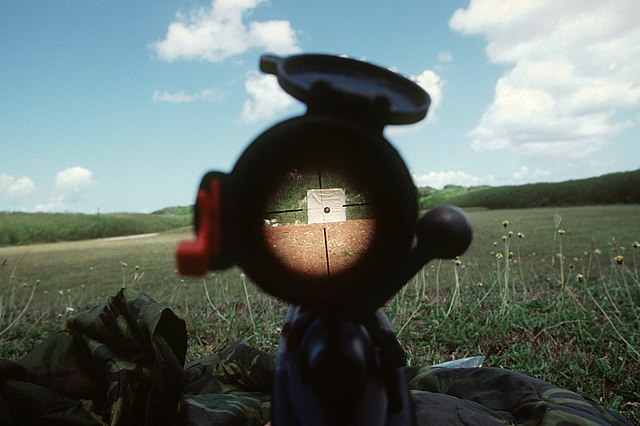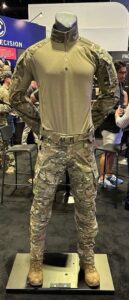Proud to present another great article by Ben Wilson from Hunting Mark.
Rifle scopes are essential accessories for shooters, offering enhanced accuracy and target acquisition.
With many options available, choosing the right rifle scope can be daunting. Understanding how scope works, the different types of rifle scopes, and their features is crucial for making an informed decision.
This article explores the various types of rifle scopes and provides insights on choosing the most suitable one for your needs.
Types of Rifle Scopes
Rifle scopes are available in various types, each designed to cater to specific shooting needs and preferences. Understanding the different types can help you make an informed decision when choosing a scope for your rifle.
Here are some of the most common types of rifle scopes:
PSL Sniper Rifle with Scope
1. Fixed Power Scopes
Fixed power scopes have a single magnification setting, such as 4x or 6x, that cannot be adjusted. These scopes are known for their simplicity and durability, making them ideal for hunters and shooters who prefer a straightforward optic.
Advantages of Fixed Power Scopes:
Durability: Fixed power scopes are often more rugged and less prone to mechanical failure due to their simpler design.Affordability: They are usually more affordable than variable power scopes, making them a budget-friendly option.Ease of Use: With no magnification adjustments, fixed power scopes are easy to use and require minimal setup.
Disadvantages of Fixed Power Scopes:
Lack of Versatility: Fixed magnification limits the scope’s versatility in different shooting scenarios and distances.Limited Field of View: Compared to variable power scopes, fixed power scopes may offer a narrower field of view at higher magnifications.
Common Uses and Applications of Fixed Power Scopes:
Fixed power scopes are commonly used for hunting, target shooting, tactical applications, training, and law enforcement. They offer simplicity, reliability, and durability, making them ideal for close to medium-range shooting where quick target acquisition is essential.
Platoon Sergeant for Scout-Sniper Platoon, with the 3 x 12 variable-power Schmidt & Bender M-854155 DS Scout Sniper Day Scope, mounted on the M-40A3 sniper rifle.
2. Variable Power Scopes
Variable power scopes allow you to adjust the magnification level, such as 3-9x or 4-12x, to suit different shooting distances and scenarios. These scopes offer greater flexibility and versatility, making them popular among hunters and long-range shooters.
Advantages of Variable Power Scopes:
Versatility: Variable magnification allows you to adapt to different shooting distances and target sizes.Enhanced Accuracy: The ability to zoom in on targets can improve accuracy, especially at longer ranges.Better Target Identification: Higher magnification levels help in identifying targets more clearly, especially in low-light conditions.
Disadvantages of Variable Power Scopes:
Complexity: Variable power scopes are more complex than fixed power scopes, with more moving parts that can potentially fail.Cost: They are generally more expensive than fixed power scopes, especially high-quality models with advanced features.
Common Uses and Applications of Variable Power Scopes:
Variable power scopes are commonly used for hunting, target shooting, tactical shooting, varmint control, and recreational shooting. They allow users to adjust the magnification based on the distance to the target and the shooting conditions, making them versatile and suitable for a wide range of shooting activities.
Vortex Spitfire HD Gen II 3x Prism Scope
3. Prism Scopes
Prism scopes are known for their compact and lightweight design, making them ideal for situations where space and weight are critical factors. They use a prism to reflect and focus light, which allows for a more streamlined optical system compared to traditional lenses.
Advantages of Prism Scopes:
Compact Size: Prism scopes are smaller and lighter than many traditional rifle scopes, making them easier to carry and handle.Fixed Magnification: Most prism scopes offer a fixed magnification, which simplifies the aiming process and allows for quicker target acquisition.Durability: Prism scopes are often more durable and less prone to failure because they have fewer moving parts than traditional scopes.
Disadvantages of Prism Scopes:
Limited Magnification: Unlike variable power scopes, prism scopes usually have a fixed magnification, which may limit their versatility in certain shooting scenarios.Eye Relief: Some prism scopes have shorter eye relief than traditional scopes, which can be uncomfortable for some shooters, especially those using high-powered rifles.
Common Uses and Applications of Prism Scopes:
Prism scopes are commonly used in tactical shooting scenarios where quick target acquisition and a compact design are crucial. They are also popular among hunters who value a lightweight and durable scope for their hunting rifles.
Night Scope on a M249
Night vision scopes are designed to amplify ambient light, making it possible to see in low-light or nighttime conditions. They use image intensifier tubes to enhance the available light, providing a clear and visible image even in the dark.
Night vision scopes capture ambient light through the objective lens. This light is then amplified by the image intensifier tube, which converts the photons into electrons. These electrons are then accelerated and focused onto a phosphor screen, where they create a visible image that the shooter can see through the eyepiece.
Advantages of Night Vision Scopes:
Low-Light Visibility: Night vision scopes allow shooters to see in low-light conditions, extending their shooting capabilities into the night.Enhanced Situational Awareness: Night vision scopes enhance the shooter’s situational awareness by providing visibility in the dark, making it easier to spot potential threats or targets.Versatility: Night vision scopes can be used for hunting, surveillance, and tactical purposes, making them versatile tools for shooters.
Disadvantages of Night Vision Scopes:
Cost: Night vision scopes are generally more expensive than traditional scopes, which can be a barrier for some shooters.Limited Range: While night vision scopes can enhance visibility in low-light conditions, they are less effective in complete darkness or in situations with no ambient light.Battery Life: Some night vision scopes require batteries to operate, and their battery life can be limited, especially when used in cold temperatures.
Common Uses and Applications of Night Vision Scopes:
Night vision scopes are commonly used by hunters who want to extend their hunting hours into the night. Law enforcement and military personnel also use them for surveillance and tactical operations in low-light conditions.
Shakhin Thermal Imaging Scope
5. Thermal Scopes
Thermal scopes use thermal imaging technology to detect heat signatures emitted by objects, animals, or people. They are highly effective in detecting targets in complete darkness or through various environmental conditions.
Thermal scopes use a special sensor called a microbolometer to detect heat signatures. This sensor can detect the heat emitted by objects and convert it into a visible image, allowing shooters to see heat signatures even in complete darkness or through smoke, fog, and light vegetation.
Advantages of Thermal Scopes:
Complete Darkness Visibility: Thermal scopes can detect heat signatures in complete darkness, allowing shooters to see in situations where traditional scopes would be ineffective.Long-Distance Detection: Thermal scopes can detect heat signatures at long distances, making them ideal for spotting game animals or detecting intruders from afar.Versatility: Thermal scopes can be used in a variety of environments and conditions, including low-visibility situations where other scopes would struggle.
Disadvantages of Thermal Scopes:
Cost: Thermal scopes are generally more expensive than traditional scopes, which can be a significant investment for some shooters.Weather Impact: Some thermal scopes may have reduced effectiveness in heavy rain or snow, as the precipitation can interfere with the thermal imaging technology.Battery Life: Like night vision scopes, thermal scopes often require batteries to operate, and their battery life can be limited, especially in cold temperatures.
Common Uses and Applications of Thermal Scopes:
Thermal scopes are commonly used by hunters for tracking game animals, as well as by law enforcement and military personnel for surveillance and target detection in low-visibility conditions. They are also used in search and rescue operations to locate missing persons or survivors in challenging environments.
Women Checking Field of View at a Competition in El Salvador
How to Choose the Right Rifle Scope
Knowing technical things like what is field of view, shooting conditions, right reticle type combined with the knowledge of practical things like your budget and your use case, among others is the best way to choose the right rifle scope.
Here are important things to consider:1. Determine Your Budget
When setting a budget for your rifle scope, consider how much you’re willing to spend based on your shooting needs and the quality of optics you desire.
Keep in mind that while affordable options are available, investing in a higher-quality scope can often result in better performance and durability.
2. Consider Your Shooting Range
Understanding your typical shooting distance will help you select the right magnification range for your scope.
A 1-4x or 1-6x magnification scope is often sufficient for close to mid-range shooting.Consider scopes with higher magnification, such as 4-16x or 6-24x for long-range shooting.
3. Think About Your Shooting Conditions
Consider the lighting conditions and environment in which you’ll be shooting. Opt for a scope with good low-light performance if you often shoot in low-light conditions, such as early morning or late evening. An illuminated reticle can significantly improve visibility in such conditions.
4. Choose the Right Reticle Type
Select a reticle type that aligns with your shooting needs. For example:
Mil-Dot Reticle: Ideal for range estimation and holdover corrections.BDC (Bullet Drop Compensator) Reticle: Helps compensate for bullet drop at various distances.Illuminated Reticle: Provides better visibility in low-light conditions.Duplex Reticle: Simple and easy to use for general shooting.MOA (Minute of Angle) Reticle: Offers precise adjustments for windage and elevation.
5. Select the Appropriate Magnification Range
Choose a magnification range based on your shooting requirements and the distances at which you typically engage targets. Higher magnification is beneficial for long-range shooting but may not be necessary for shorter distances.
6. Consider the Size and Weight of the Scope
Ensure that the scope’s size and weight are suitable for your rifle and intended use. A lightweight and compact scope is preferable for hunting and maneuverability, while a larger, heavier scope may be more suitable for benchrest shooting or long-range precision shooting.
7. Check for Durability and Weather Resistance
Look for scopes that are built to withstand the elements. Features such as fog-proofing, waterproofing, and shock resistance are crucial for maintaining performance in challenging conditions.
8. Look for Additional Features
Consider any additional features that may enhance your shooting experience, such as:
Parallax Adjustment: Helps maintain a clear sight picture at different distances.Zero-Reset Turrets: Allows for quick and easy adjustments to zero without the need for tools.First Focal Plane Reticle: Reticle size adjusts with magnification, maintaining its relative size to the target for accurate holdover and ranging at all magnification levels.
Final Words
Choosing the right rifle scope involves understanding the various types available, considering factors such as budget, shooting range, and features, and selecting a scope that meets your specific needs. Doing so can enhance your shooting experience and improve your accuracy in the field or at the range.
Check out more awesome articles from Ben Wilson at Hunting Mark, here.
Share This



